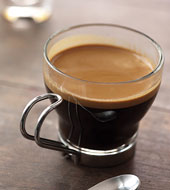Starbucks espresso Espresso

Espresso Espresso

This is the essence of coffee, shown in the most concentrated way. Starbucks espresso is rich with a touch of caramel.
One ounce of espresso is also called single, while two ounces of espresso is called double.
Rich espresso is the soul of Starbucks. Its rich flavor, persistent aroma and slightly caramel sweetness are at the heart of making lattes, cappuccinos and other espresso-based coffee drinks. You can also try a variety of flavors alone, and you may be able to find nuances. Source: www.starbucks.cn, the official website of Starbucks
Important Notice :
前街咖啡 FrontStreet Coffee has moved to new addredd:
FrontStreet Coffee Address: 315,Donghua East Road,GuangZhou
Tel:020 38364473
- Prev

Starbucks Espresso Con Panna
Espresso Con Panna topped espresso with whipped cream. Con Panna means whipped cream in Italian. This is a great introduction to espresso, especially for those who don't know if they can handle strong coffee yet. The addition of creamy whipped cream gives espresso such a wonderful neutralisation, of course.
- Next

Starbucks latte Caff è Latte
Latte Caff Latte this is a traditional classic drink espresso mixed with hot milk and covered with a light layer of foam. When tasting this coffee, you can choose to add syrup with a special flavor (such as vanilla, caramel or almond). What is a latte? Latte is the transliteration of Italian Latte, which means milk. And what we call a latte is milk coffee. Bottom
Related
- Beginners will see the "Coffee pull flower" guide!
- What is the difference between ice blog purified milk and ordinary milk coffee?
- Why is the Philippines the largest producer of crops in Liberia?
- For coffee extraction, should the fine powder be retained?
- How does extracted espresso fill pressed powder? How much strength does it take to press the powder?
- How to make jasmine cold extract coffee? Is the jasmine + latte good?
- Will this little toy really make the coffee taste better? How does Lily Drip affect coffee extraction?
- Will the action of slapping the filter cup also affect coffee extraction?
- What's the difference between powder-to-water ratio and powder-to-liquid ratio?
- What is the Ethiopian local species? What does it have to do with Heirloom native species?

